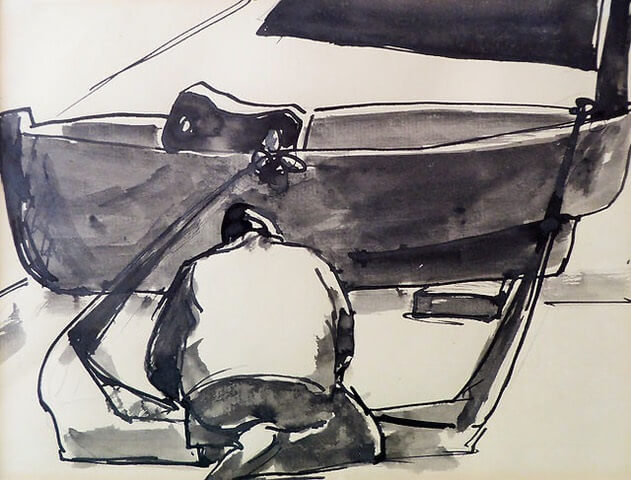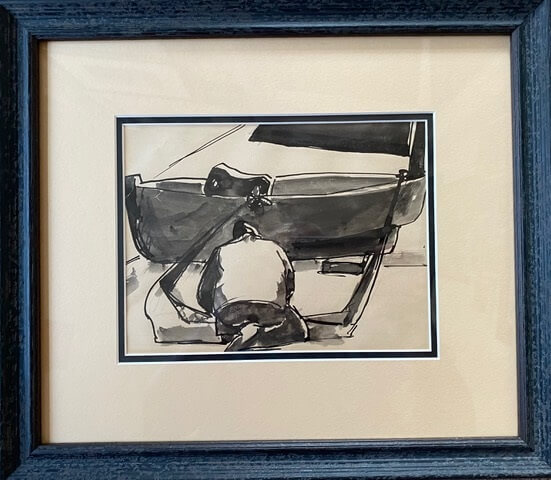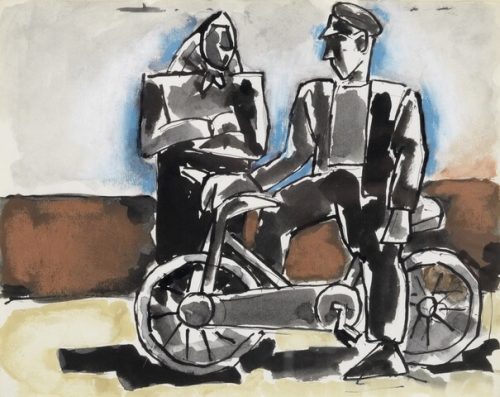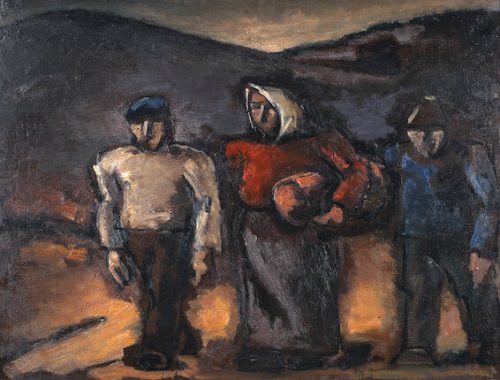Fisherman preparing his boat
Dimensions
15.5cm x 21cm or 6.25" x 8.25"
Medium
Ink & wash on paper
Price
£1,600
Josef Herman
Highly regarded Polish-British painter who influenced contemporary art, particularly in the United Kingdom. He was from a generation of eastern European Jewish artists who emigrated to escape anti-Semitism and Nazi persecution in 1930s/40s. Born in 1911 into an impoverished Polish-Jewish family, he attended the Warsaw School of Art and worked briefly as a graphic artist. In 1938 Herman left Poland for Brussels where he was introduced to many eminent artists. After the beginning of World War II and the German invasion of Belgium, he escaped to France and then fled onto Britain. In 1942 Herman learned through the Red Cross that his entire family had perished in the Holocaust. He first lived in Glasgow, where he met fellow artist Jankel Adler, and between 1940 and 1943 he contributed to a remarkable wartime artistic renaissance in the city. He then moved to London, where he met numerous other European émigré artists, such as the Hungarian, Michael Peto, with whom he became a firm friend. In 1943 he held his first London exhibition with L.S. Lowry. At the height of his career, Herman was recognised as one of the leading figurative artists of the time. A realist painter capturing the essence of labour, his own style was bold and distinctive, involving strong shapes with minimal detail. He believed Art has to leave out more than to include, thereby absorbing the viewer to explore their own imagination and interpretation. Herman had respect for the dignity of ordinary people, especially those who labour with their hands, particularly ordinary folk toiling the land to eke out a living. His study of working people as the subjects of his pictures became of particular interest during the eleven years he lived in the coal mining town of Ystradgynlais, South Wales. There he was inspired and soon became an integral part of the enduring close-knit community where he was fondly nicknamed ‘Joe Bach’ (Little Joe). Herman is quoted as saying: "I stayed here because I found all I required. I arrived a stranger for a fortnight. The fortnight became eleven years." When commissioned in 1951 to paint a mural for the Festival of Britain, Herman took coal miners as his subject whom he respected and wanted to honour. His work ‘Miners’, showing six men resting above ground after their work, is held in the permanent collection of the Glynn Vivian Art Gallery, affiliated with the Swansea Museum. The success of this commission depicting his deep human insight was to establish his national reputation as an artist. Leaving Wales in 1955 because his health was affected by the damp climate, Herman lived briefly in Spain, Suffolk and in 1972 he finally settled in West London. In 1961 he married his long-time partner, Nini Ettlinger (1925-2015) whose life was filled with considerable literary and medical achievements. They had three children, one of whom they adopted. Herman died in 2000. The execution of Herman’s work appears superficially simple, yet it is both powerful and expressive. He was awarded the Gold Medal for Fine Art at the 1962 National Eisteddfod of Wales. In 1981 he was awarded an OBE for services to British Art. He was elected to the Royal Academy of Arts in 1990. His highly acclaimed work is represented across the five continents in numerous museums and distinguished collections. jmgArt holds a fine selection of Herman’s ink and wash artworks on paper. They depict scenes of ‘harvest toil’ and ‘village life’. Some are signed on the back by the artist. Each is a unique example from earlier periods of his career. These distinctive and rare artworks are available to purchase either framed or unframed. Please contact jmgArt for further information
Artwork Enquiry
Other Artwork by the same Artist
copyright jmgArt 2024 | Red 13 Website Design





